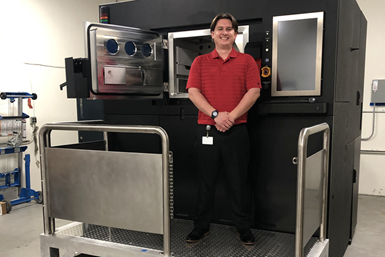Velo3D System Chosen for Aftermarket Gas Turbine Parts Production
Additive manufacturing will help keep aging engines operational with greater flexibility and shorter delivery times than traditional MRO supply chains.
Share
Read Next

Zack Hopkins, an engineer at Chromalloy Gas Turbine, stands next to its Velo3D Sapphire metal additive manufacturing system.
Chromalloy, a manufacturing and repair solutions provider for gas turbine engine manufacturers and operators, recently selected the Velo3D Sapphire system as its additive manufacturing (AM) solution. Chromalloy chose the system in order to impact the economics of future maintenance, repair and operations (MRO) projects in its aviation and energy markets, the company said.
Chromalloy is installing the Velo3D Sapphire in its manufacturing and repair services environment. This industrial AM technology is being adopted by manufacturers as a solution to offset the high costs of low-volume, direct-part replacement for conventionally produced parts when demand and long-term forecasting are uncertain.
“Chromalloy continues to seek innovative alternatives for our customers to extend the life of their engines and reduce their MRO costs,” says John Green, vice president, engineering and technology, Chromalloy. “The Velo3D additive manufacturing equipment provides a unique, practical solution for our proprietary LifeX customer solutions.”
For Chromalloy, 3D printed parts must provide inherent value because they are 3D printed. “Otherwise, the printing itself is just a novelty,” says Jim Whitton, Chromalloy’s director of innovation strategy. “Velo3D’s unique build capability and material density create high value by reducing postprocessing requirements.”
Velo3D will qualify Chromalloy’s machine for 3D printing nickel-based superalloys, including HastelloyX, which is known for its strength and durability characteristics in high-temperature environments. Velo3D is known for enabling geometric freedom through its SupportFree process. The capability to produce practically unlimited geometries eliminates the need to redesign legacy parts in order to produce them with AM. This reduces the barrier of transitioning legacy parts (produced historically by casting, welding or brazing) to AM, the company says.
“For complex gas turbine combustor components that have limited aftermarket availability or high replacement cost, the Sapphire system will allow Chromalloy to produce hardware on-demand, negating high NPI (new product introduction) tooling costs and lead times of other methods,” Whitton says.
Related Content
-
How Norsk Titanium Is Scaling Up AM Production — and Employment — in New York State
New opportunities for part production via the company’s forging-like additive process are coming from the aerospace industry as well as a different sector, the semiconductor industry.
-
Beehive Industries Is Going Big on Small-Scale Engines Made Through Additive Manufacturing
Backed by decades of experience in both aviation and additive, the company is now laser-focused on a single goal: developing, proving and scaling production of engines providing 5,000 lbs of thrust or less.
-
Video: 5" Diameter Navy Artillery Rounds Made Through Robot Directed Energy Deposition (DED) Instead of Forging
Big Metal Additive conceives additive manufacturing production factory making hundreds of Navy projectile housings per day.














